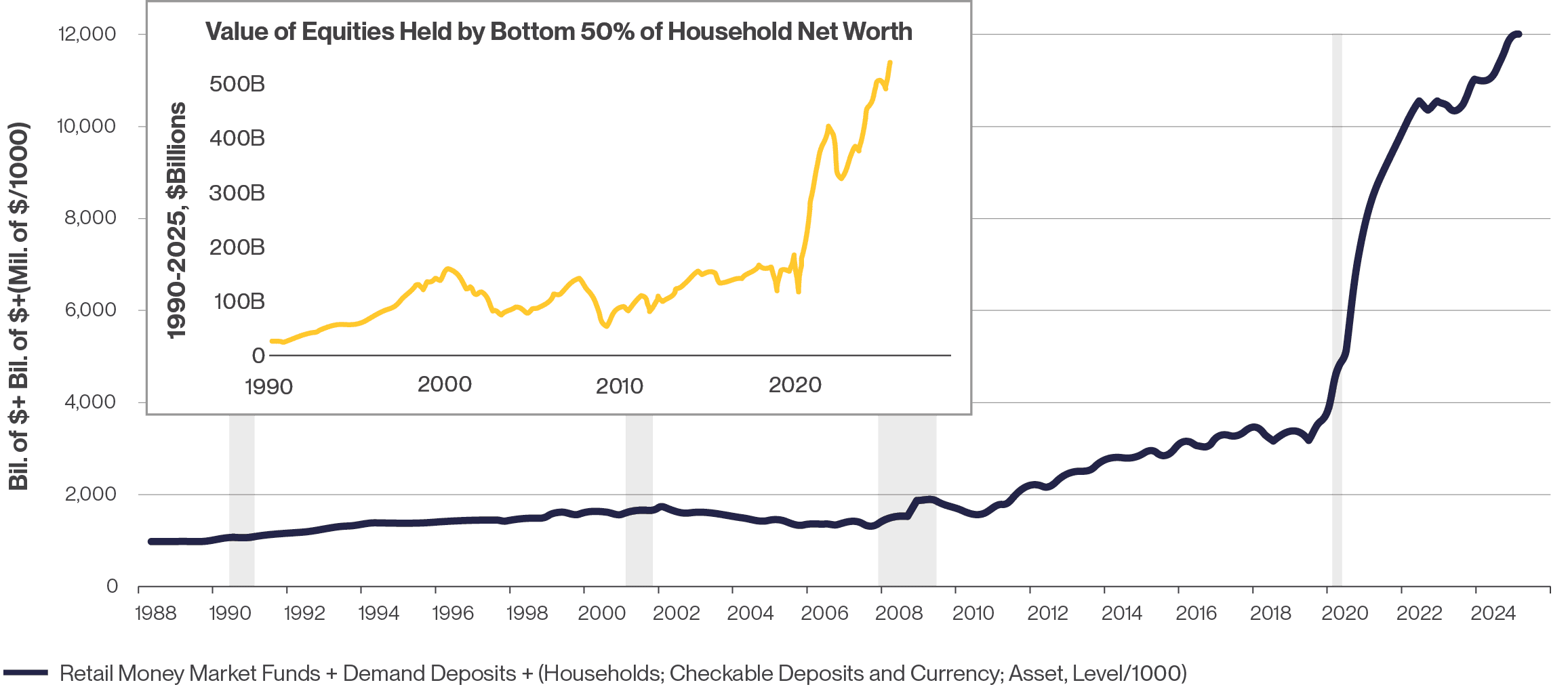Muddle, Bust, or Boom? Scenarios for the Economy and Consumers
OVERVIEW
The third quarter of 2025 reinforced the year’s defining pattern — a series of fluctuations and mixed signals that leave investors grappling with how the economy will evolve from here. Even still, several positive developments stood out:
- Financial markets rallied strongly, with several equity indices repeatedly hitting new highs.
- Economic growth data, particularly consumer spending and retail sales, were more robust than anticipated, showing improvement from earlier in the year.
- Unemployment remained relatively low by historic standards.
- The Federal Reserve Board cut a key short-term interest rate for the first time since 2024 in a move designed to lower the interest that businesses and consumers pay on their debt.
However, beneath that hopeful surface are troubling signs that key parts of the economy and markets are losing momentum. The road to the rate cut may have been paved with good economic intentions, but many interpret this step as a signal that the economy needs support to avoid a deeper downturn — or even a recession. These concerns, combined with other data points, are fueling doubts that overall growth, corporate profits, and investment returns can hold up in the months ahead.
- Hiring slowed significantly during the quarter, indicating that the rapid pace at which employers have been adding workers in recent years is losing momentum.
- The Bureau of Labor Statistics sharply reduced job growth data from earlier in 2025, signaling that the job market has been weaker for longer than many investors realized.
- Inflation remains above the Fed’s target rate, with some spending categories experiencing sharp increases in already rising prices, sparking concern that the Fed’s rate cut could trigger an unwanted resurgence in inflation.
- Consumer confidence fell to its lowest level since April, when President Trump first announced his plan to levy large tariffs on other nations, causing markets to temporarily plummet.
So, where do we go from here? Given the volume of conflicting signals, it’s not surprising that we’re seeing considerable disagreement among market watchers today about how inflation, the economy, and financial markets are likely to evolve. Assessing the future requires investors to acknowledge that the current outlook is uncertain. Much-needed clarity is also limited, especially given that the fourth quarter has begun with a federal government shutdown that has stopped the flow of important economic data.
Rather than forecasting a single central expectation, we believe it’s better to examine three potential scenarios that could unfold in the coming months.
THREE POSSIBLE PATHS FORWARD
Scenario #1: Muddle Through
In a muddle-through scenario, we’d anticipate a continuation of mixed data signals, particularly focused on a cooling labor market and a strong U.S. consumer. For example, hiring momentum has slowed – as we saw in August, the economy added only 22,000 new jobs, falling short of the anticipated 76,500. The hiring rate among private companies is also hovering near historically low levels (see Exhibit 1).
EXHIBIT 1: U.S. FEDERAL AND PRIVATE HIRES RATES
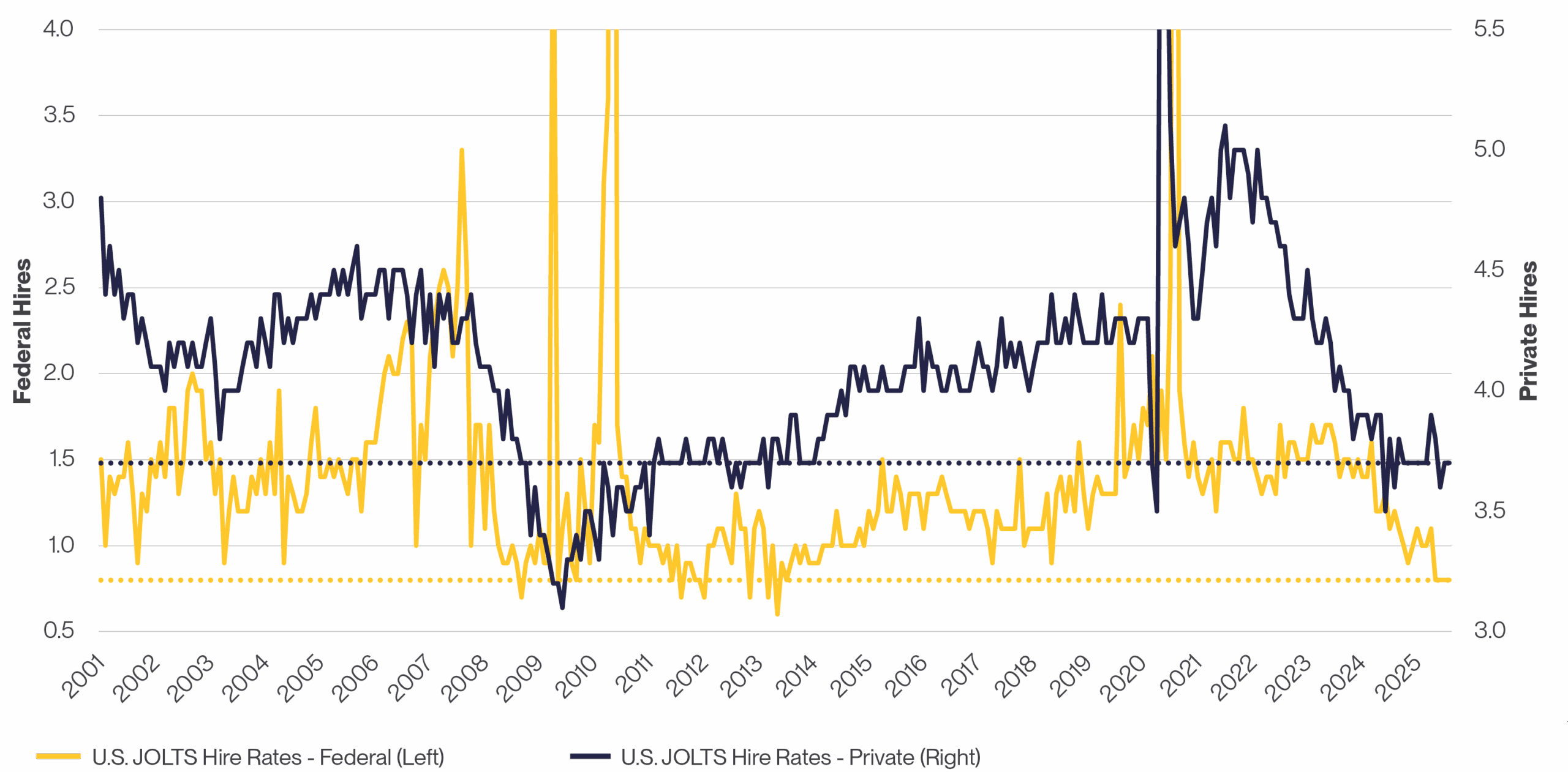
Job Opening and Labor Turnover Summary (JOLTS)
Bloomberg, calculations by Horizon, 08/29/2025
However, those numbers overlook some important positives:
- Layoffs and firings are rare: The “low-hire” environment is being largely balanced by a “low-fire” mentality among businesses, as companies are hesitant to reduce the size of their existing workforces. The current rate of layoffs per 100 jobs in the private sector is just 1.2 — higher than it was a year ago, but still below pre-pandemic levels.
- Long-term unemployment is low: Although the labor market has somewhat weakened, it’s done so from a position of historic strength. Exhibit 2 shows that the share of the U.S. labor force experiencing ongoing unemployment remains near the record lows of 2022 and 2023.
EXHIBIT 2: PERCENT OF U.S. LABOR FORCE FACING CONTINUING UNEMPLOYMENT
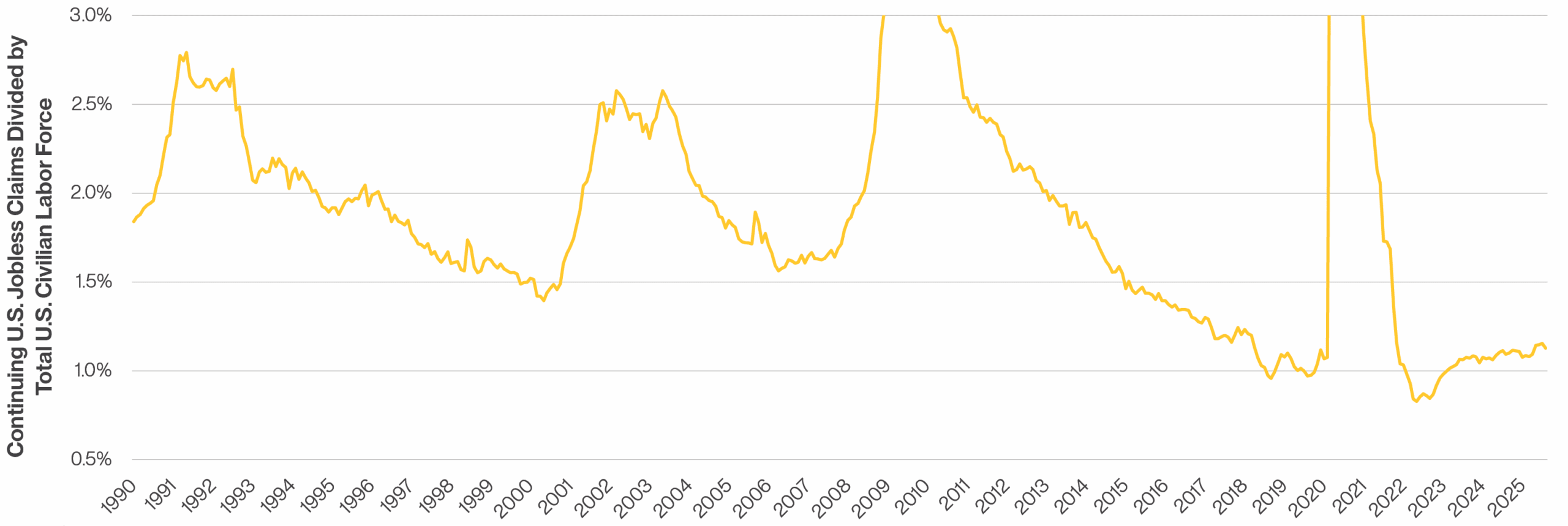
Bloomberg, calculations by Horizon, 08/29/2025
Scenario #2: Growth Bust
That said, the labor market’s cracks could become full-on crevasses, leading us to a “growth bust” scenario. If the labor market suffers a major downturn or if fears of sudden unemployment start to accelerate, consumers, whose spending accounts for around two-thirds of U.S. economic activity, will likely tighten their purse strings. In that environment, an economic recession becomes a highly probable outcome.
Another area that investors need to closely monitor is corporate spending on artificial intelligence (AI) and other technologies. In recent quarters, technology spending has become a significant driver of gross domestic product (GDP) growth (see Exhibit 3). Companies are spending enormous sums on technology, particularly AI, and investors are rewarding those companies with higher valuations. Given how much this spending is helping support the overall economy, an unexpected reduction in tech capital expenditures could significantly weigh down growth.
EXHIBIT 3: U.S. REAL GDP GROWTH CONTRIBUTORS
J.P. Morgan, 09/02/2025
Scenario #3: Growth Boom
A third scenario involves growth accelerating from current levels, with both the economy and corporate profits strengthening. This outcome could result from factors such as:
- Government policy: The domestic policy bill passed by Congress this summer is designed to push corporate tax rates down to historically low levels (see Exhibit 4), providing a boost to corporate profits going forward. Additionally, continued deregulation efforts by the Trump administration could benefit businesses’ top and bottom-line growth.
EXHIBIT 4: U.S. EFFECTIVE CORPORATE TAX RATE
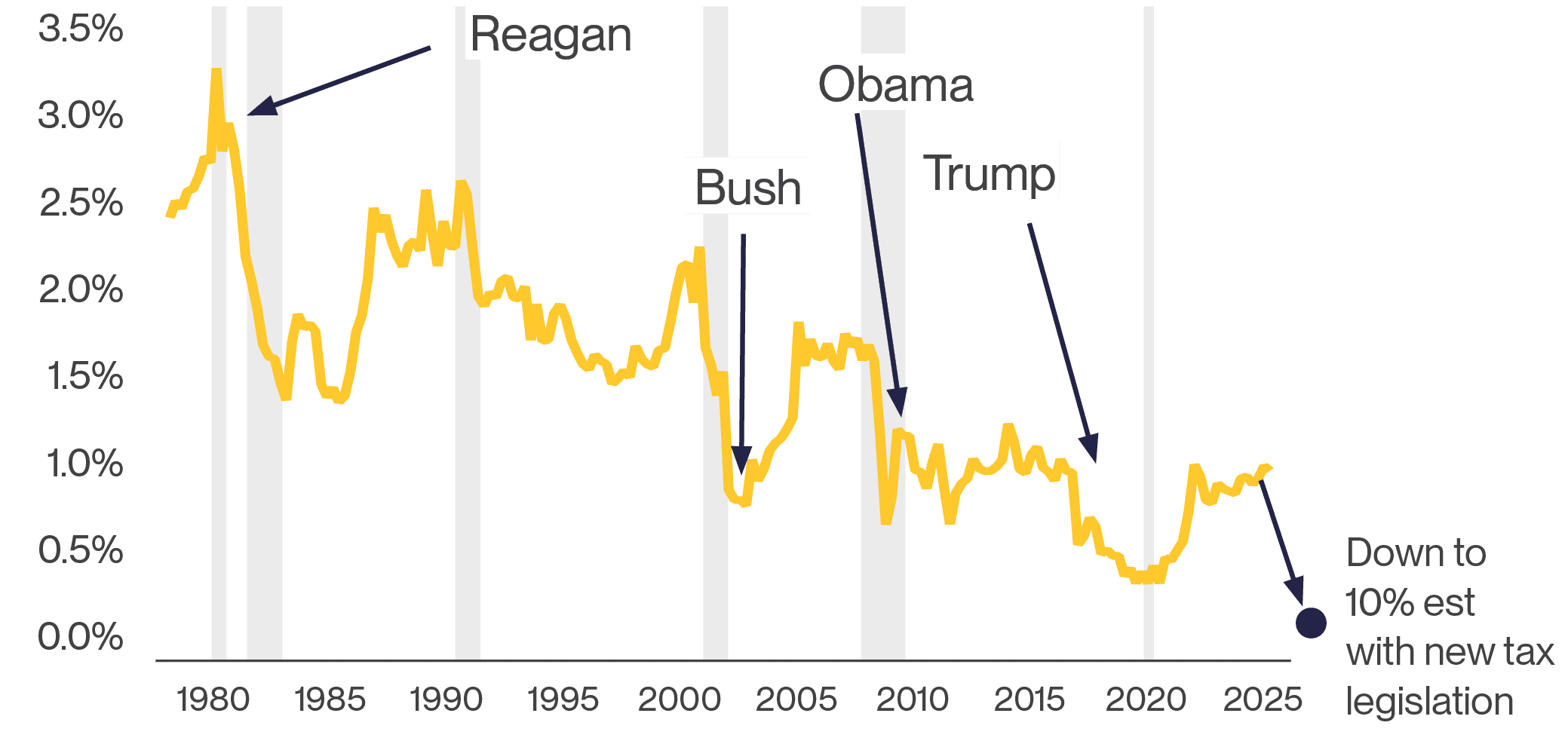
Piper Sandler, 09/17/2025
Information obtained from third party sources is believed reliable but has not been vetted by the firm or its personnel.
- Stronger consumer spending: Despite the falling consumer confidence noted above, the fact remains that consumers across wealth levels continue to be flush with liquidity and potential spending or investing power. Exhibit 5 shows that consumer assets held in money market funds and deposit accounts recently hit an all-time high, as did the value of equities held by households in the bottom 50% of net worth. Any number of developments, lower interest rates or greater trade policy clarity, for example, could prompt consumers to deploy that money into the economy, the financial markets, or both.
EXHIBIT 5: AMERICAN CONSUMER STILL FLUSH WITH LIQUIDITY
Shaded areas indicate U.S. recessions
Federal Reserve of St. Louis, 09/29/2025
Citadel Securities, 09/29/2025
Information obtained from third party sources is believed reliable but has not been vetted by the firm or its personnel.
CONCLUSION
Each of these three scenarios comes with its own distinct implications for the economy, financial markets, and the Fed, which we’ve summarized below:
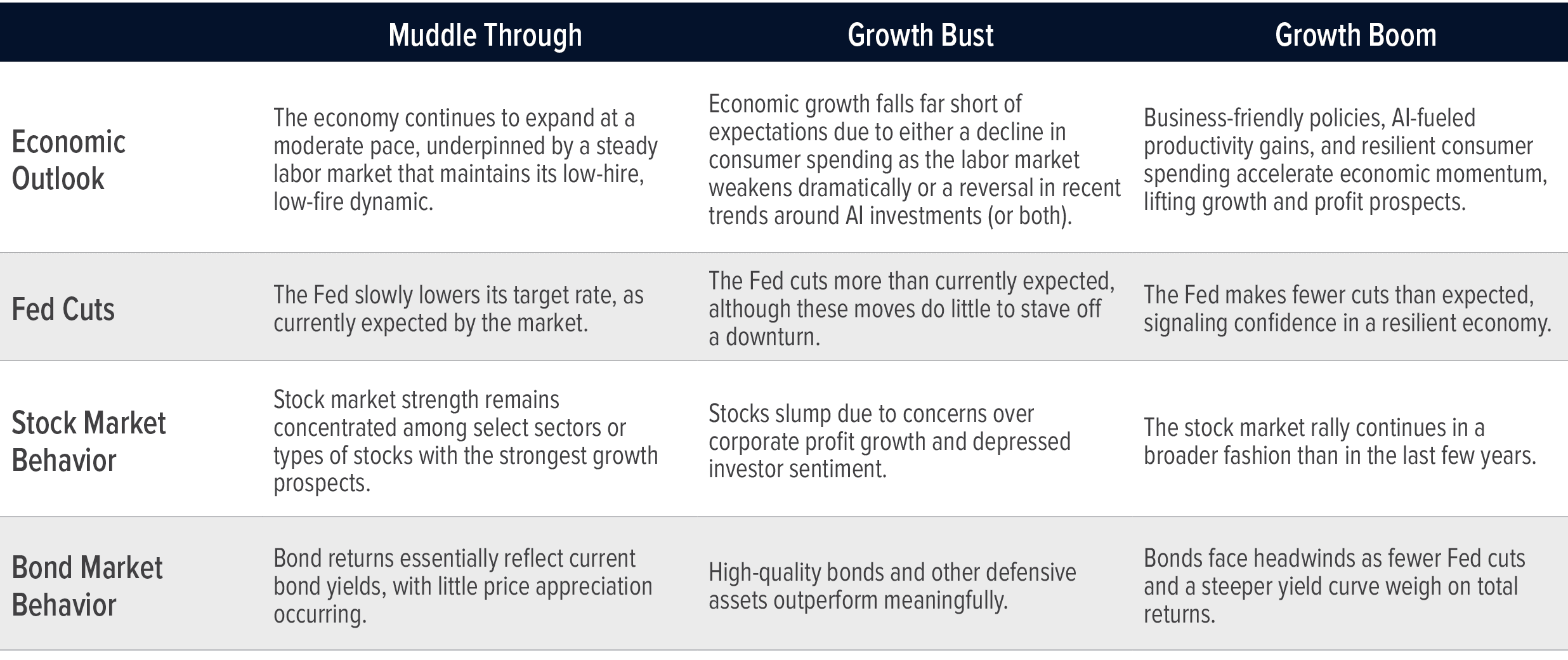
Over the next few months, our attention will remain focused on the labor market, consumer confidence, and spending patterns, as well as trends in the AI mega theme. Inflation readings and tariff impacts will affect both corporate profit expectations and adjustments to the Fed’s monetary stance.
No matter which of the three scenarios unfolds in the coming months, we will continue to apply both quantitative and qualitative insights to build resilient portfolios, designed to deliver thoughtful diversification amid uncertainty.




